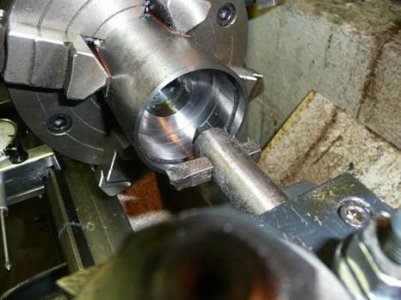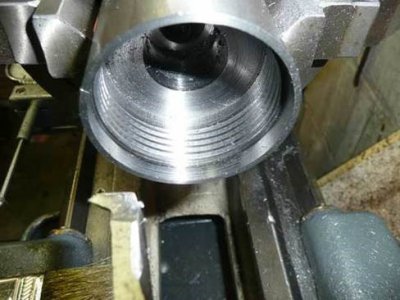- Joined
- Jan 19, 2018
- Messages
- 900
It’s a bit different than OD and you need to prepare the work.
You said 1-7/8 spindle. I assume, from my data that its an 8-tpi thread.
The pitch of that thread is 0.125”. The Double Depth is 0.160” The diameter you want to bore for the threads is 1.740 to 1.754.
You will need a step, for thread relief, of 1.875 on the input to the threads and, if its not a through hole a step one the end of the threads. I would make the exit step at least two turns, for your 8tpi thread that’s 0.250” I would make the input step the same if you have room.

Here is a picture of an input relief for a 2-1/4 8 thread. If you look carefully you can see both the input and output relief. It’s better if the input step has an angle.
Now you have three backlashes to worry about. The compound, the cross feed and the leadscrew.
I assume you have turned the workpiece and it is true to the spindle.
You need an ID threading tool. Could be a threading tool mounted on a boring bar or one like in the second picture. Boring bar makes it nice and ridged.
If you are threading to a step, you will also need some way to measure the threading tool depth as you are threading.
I like to use a way mounted DI.
The compound should be set at 60 degrees.
Making sure the compound is fully engaged on the ways and roughly centered in the opening, turn the compound dial two or three turns clockwise, then two or three turns COUNTER CLOCKWISE.
Set the scale to zero. From this point NEVER turn the compound clockwise until the thread is cut. (This removes backlash in the compound.)
Next bring the saddle toward the work. Center the tool, at the beginning in the thread area. (It helps to coat the thread area with dye. )
Adjust your DI or however you will measure the depth so you know when to stop threading.
With the lathe running, on the slowest speed, no feed and SLOWLEY turning the cross feed COUNTER clockwise watch for the tool to JUST touch the thread area. (By starting in the middle, or at least 1 full turn of the dial away from the surface, you have removed cross feed lash. ) Stop the lathe and set the dial on the cross feed to ZERO. Rotate the cross feed CLOCKWISE ONE turn.
Back the saddle away from the work ¼”. (This allows room to remove backlash in the leadscrew.)
Rotate the cross feed COUNTERCLOCKWISE to zero.
Rotate the compound COUNTERCLOCKWISE to 0.0025”
Start the lathe, wait for the thread dial to come to a number.
Engage feed and take your first pass.
STOP the feed when you reach your depth.
Turn the cross feed one full turn CLOCKWISE.
Back the saddle away from the work so there is ¼” of travel between the work and the tool.
Now is a good time to check the thread pitch with a scale to insure you set the feed up properly.)
Return the cross feed dial COUNTERCLOCKWISE to zero.
Advance the compound COUNTERCLOCKWISE to 0.005”
Start the lathe and when you Thread dial comes around to your number or line engage the feed.
STOP when your tool has cleared the thread area. Stop the lathe.
Back the tool out of the thread by turning the cross feed 1 full turn CLOCKWISE.
Move the saddle back so the tool clears the work by ¼”
At this point I take a free pass. DONOT advance the compound.
Return the cross feed to zero by turning COUNTERCLOCKWISE.
Start the lathe. When you thread dial comes around to your number/line engage feed.
Stop at the end of the cut. Stop the lathe Back out the cross feed 1 full turn. Move the saddle out leaving ¼” gap to the work.
Repeat the above 9 more times. ( this will give you a thread depth of 0.020” You need a depth around 0.080”
Because you are moving at 60 degrees it’s really 0.080/.866 = 0.092” indicated on the compound dial.
You should now advance at a slower rate, 0.0015/0.0015/0, for 10 more times and then 0.001/0.001/0 until you have a depth on your compound of 0.080.
You now need a test fit.
If its tight try a few more “Free” passes. Still tight advance in steps of 0.0005 with several free passes.
Should look like this.

That picture shows a shop made ID threading tool
This is an ER-40 collet chuck for the Heavy 10.
If you screw up the first time Its OK. Been there, Done that.
Best to try on a blank of any kind.

